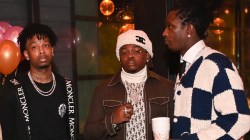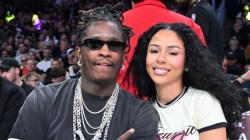Five years is a brief duration but enough time for substantial evolution. It’s been half a decade since Wiz Khalifa released Kush & Orange Juice, his breakthrough project, which set Twitter ablaze and thrust the Pittsburgh native’s stoner charm into the public eye. That larger audience devoured Wiz’s sedated charisma, resulting in the rapper’s meteoric rise into the mainstream. In five years, his sound has transitioned from something traditionally Hip Hop to something that warps genres. This, coupled with his physical transformation, has prompted old fans and critics alike to wonder what happened to the “old Wiz.” The change is quite overt, but beneath the tattoos and dreads lies remnants of the same artist who became a star on the strength of a wake and bake routine back in 2010.
The unspoken truth about Wiz Khalifa’s progress is that Kush & Orange Juice was the refinement of his sound, not the genesis of it. The spaced-out trudge of last year’s Grammy-nominated “We Dem Boyz” is an alternative vibe similar to the sweaty, Eurodance energy of his first single, 2008’s “Say Yeah.” Following his departure from Warner Bros. Records in 2009, he flashed development on How Fly, his collaborative project with Curren$y released the same year. A few months later, he released Burn After Rolling and his independent album Deal or No Deal. Both showed Wiz’s potential, but also made it clear that his style was still in its cocoon. Kush & Orange Juice represented him finally sharpening that sound after a trial process, and the payoff was equally rewarding for Wiz and his audience.
Part of the reason Wiz was able to get #kushandorangejuice trending on Twitter and similar traction on Google is because listeners immediately knew he had turned the corner musically. Once the haze of “Waken Baken” faded and producer Cardo’s hallmark synths and 808s emerged on “Mezmorized,” it was evident that Wiz had found himself. In addition, he sounded more confident than ever on the latter, which opened with the brash “I don’t love ‘em / I don’t chase ‘em, I duck ‘em” proclamation. “The Kid Frankie,” with its Loose Ends sample, evoked the ethos of DJ Quik’s “Tonight.” That California house party vibe extended to the trance-like bounce of “Never Been” and “In the Cut.” Wiz’s conversational harmonizing over the simple production of “Up” make the song a true reverie. The “Slim Skit” is a blaxploitation film-esque soliloquy over an instrumental Willie Hutch himself would be proud of.
It’s not the bounty of weed references which make Kush & Orange Juice a stoner rap classic, it’s the vibe. “Still Blazin” is probably the most direct nod, and “Glass House” also featured Curren$y and Big K.R.I.T, whose success is similarly built on the followings they developed during the Smokers Club era of Hip Hop born around the beginning of this decade. The personality Wiz flexed on Kush & Orange Juice landed him a deal with Atlantic Records, and, by early 2011, he was dating Amber Rose and performing his Pittsburgh anthem, “Black and Yellow,” at Heinz Field during halftime of the AFC Championship Game. Just weeks before the release of his major label debut, Rolling Papers, he told HipHopDX that Kush & OJ was the catalyst for all of this.
“It was a total set-up for [the success I’m having now]. Kush & Orange Juice, I had done maybe six or seven projects, maybe, before I had done Kush & Orange Juice. That was the biggest one for me,” he admitted. “That’s the one that [gave] me the most new fans. My original fans, that’s what made them to most happy. It was just a really, really good point for music in general, for a young artist to come with something that creative and that new.”
But the anticipation for Rolling Papers was ultimately offset by the disappointment of his core fans upon its arrival.
The Wiz Khalifa fans that watched him grow from “Ink My Whole Body” expected Rolling Papers to be another to Kush & OJ. The release of his Cabin Fever mixtape a month prior also gave the impression that the album would carry a more aggressive sound thanks to the mixtape’s menacing atmosphere, crafted largely around menacing production courtesy of Lex Luger. Disney movie fare like “Roll Up” and the PG-13 “No Sleep” were jarring in contrast, as, overall, Rolling Papers felt like a intentional grab for commercial success. Songs like “On My Level” and the Curren$y-assisted “Rooftops” alluded to his previous work, and the reminiscent “The Race” remains one of his best songs, but Rolling Papers forced Wiz’s day one audience to consider the possibility that they had lost the lanky rapper—who, at the time, was sporting a blonde patch in his hair—to advanced levels of weed and fame. Fortunately, Wiz’s receptive ear never strayed.
In February 2012, just days after making his first trip to the Grammys on the strength of “Black and Yellow,” Wiz wrote an open letter to his fans. In it, he admitted that Rolling Papers was a miscalculated deviation. “I remember when I made Kush and Orange Juice, I listened to it and knew I had created a new genre that would change music,” he wrote. “The mistake I made on Rolling Papers was thinking it was time to move on from that genre not knowing that it had impacted people so much.” Acknowledging that Rolling Papers was far from “his best work” despite its commercial success, he promised to remedy the situation with a new mixtape recapturing the essence of what made Wiz Khalifa ascend the next plateau.
Taylor Allderdice, a vowed return to form, was nearly a tracing of Kush & Orange Juice’s blueprint as far as structure. The intro, “Amber Ice,” evoked hazy memories of “Waken Baken.” It was followed by the Cardo-produced “California,” where Wiz reflected on criticism in the wake of his progress: “Now that my money right them suckers keep thinking I’m wrong/But I’m just switchin’ lanes, foot off the brake and I’m gone.” For the second “Never Been,” he enlisted the distinct voices of estranged wife Amber Rose and Rick Ross to bolster that familiar thump. There’s minimal breadth to the content of Wiz’s lyrics, but he was able to incorporate traces of what he picked up along the way. “Nameless” has the mid-90s swing of an Easy Moe Bee beat from that era, and “My Favorite Song” and “T.A.P.” are Three 6 Mafia homages featuring Taylor Gang’s resident drunk uncle, Juicy J.
Named after the high school he attended, Taylor Allderdice represented Wiz revisiting his origin. But with the seasoning gained from his leap into the spotlight, he turned around a project less impactful, but more polished than Kush & Orange Juice. With the right amount of momentum and energy, it was the perfect lead-in to his second album, O.N.I.F.C.
Based on a song from Taylor Allderdice, O.N.I.F.C. had less pop appeal than Rolling Papers, but still contained terrestrial radio fodder. Despite being a bit schizophrenic, its high points are heavy with what made Wiz famous. On “The Bluff,” he linked with Cam’ron, addressing everyone who accused him of changing: “Still the same nigga/Still walkin’ up on your airplane with all of my gang members.” Pharrell joined him on “Rise Above,” where Wiz again croons about ignoring critics and detractors in the voice honed since putting it to perfect use on Kush & Orange Juice. But it’s the reflective “The Plan” which stands out as the album’s gem. Breezy yet triumphant, it’s a subtle flex where Wiz asserts his prosperity. Still, fans unsatisfied by his step in another direction and radically different appearance continued to clamor for the “old Wiz”, a longing which continues today.
The change in Wiz Khalifa’s music is personified by the dramatic augmentation of his look. In five years, it’s gone from your friendly campus weed dealer to rock star. His tattoos have always been numerous, but now they adorn his face. The semi-clean-cut appearance has been abandoned in favor of dreads, which were dyed purple at one point last year. While this change does represent the freedom associated with the financial spike from six figures to seven, it’s more about Wiz embracing the unbound spirit that has always lived inside of him. He explained this in his 2012 open letter.
“Anyone questioning my choice in clothing as of lately (lol) I’ll just go out and say that it was needed,” Wiz wrote. “In a climate where everyone is looking and sounding the same, I always try to inspire my fans to be different. And I lead by example. At one point the way I used to dress was considered ‘different’ but now its very much the norm and accepted.” He may look different, but the artist everyone claims to miss returns when he works with Curren$y.
How Fly’s cult-classic status was the result of natural chemistry between the two. More importantly, it was the birth of their dynamic: Curren$y bringing out Wiz’s best. Spitta’s attention to detail forced Wiz to be more focused, and it was heard on the project’s surface-to-air missile of an opener, “Car Service.” In a 2014 interview with Wiz, HipHopDX noted that Curren$y explained their alleged divergent paths since How Fly’s release.
“My man Wiz, he wanted to be a planet, like a rock star,” he said. “I wanted to be in the cut with a couple of low-riders and doing my thing. Now we’re here, and god damn it, my man is a planet! We got what we wanted.”
Their 2013 re-up, Live in Concert, may have paled in comparison to How Fly (Ron Burgundy flutes and all), but whenever it seems like Wiz has strayed too far from his source, Curren$y reels him in. “The 560SL” from his Pilot Talk lll and “Uber Driver” demonstrate as much. From composition to theme, the latter is the sequel to “Car Service.” It’ll appear on their #2009 joint effort, which aims to align that old Cheech and Chong rapport with their present standings within Hip Hop’s universe. Wiz is as aware as any artist that the past can’t be duplicated.
A few weeks after Wiz Khalifa’s third album, Blacc Hollywood, hit stores last summer, The Fader asked how he would respond to fans still holding out for a second Kush and Orange Juice. “I would say that that’s cool for them to want that. That’s fair,” he said. “But you know, at the end of the day, I don’t think I could ever do that again because that was brand new. You could never be brand new all over again.” His answer shows that Wiz grasps the concept of progression; Kush & Orange Juice represented who he was at that time. It was built up to be this larger than life entity that Wiz refuses to live in the shadow of. Five years later, he’s a 27-year-old separated father of one who’s made millions of dollars. His outlook and attitude may be the same, but that combination of life experience and wealth has changed him—as it should’ve. As for his style, it’s no more than personal growth drawing out the hippy he was at the core. It’s fair to expect quality equivalent to Kush & Orange Juice from Wiz, but expecting a carbon copy is futile.
Julian Kimble has written for Complex, Pitchfork, the Washington Post, Billboard, Gawker, Vibe, the Washington City Paper and more. Follow him on Twitter @JRK316.










wiz has always been average as fuck he aint no mc and got a terrible flow. All he raps about is weed n things he gonna buy and every fucking interview is the same weed talk followed by that goofy ass laugh nigga be annoying
Has Wiz really ‘evoled’ over the years? I would much prefer an editorial on someone more deserving.
Kush and O.J was wiz at his best, when he is not alongside Spitta but IMO there is no depth to his music… Life is good, Im Rich, Your not, smoke a lot, zzzzzzzzzzz
Devolution
His verse on 560SL is… not good.